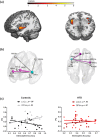Multilevel convergence of interoceptive impairments in hypertension: New evidence of disrupted body-brain interactions
- PMID: 29271093
- PMCID: PMC6866355
- DOI: 10.1002/hbm.23933
Multilevel convergence of interoceptive impairments in hypertension: New evidence of disrupted body-brain interactions
Abstract
Interoception, the sensing of visceral body signals, involves an interplay between neural and autonomic mechanisms. Clinical studies into this domain have focused on patients with neurological and psychiatric disorders, showing that damage to relevant brain mechanisms can variously alter interoceptive functions. However, the association between peripheral cardiac-system alterations and neurocognitive markers of interoception remains poorly understood. To bridge this gap, we examined multidimensional neural markers of interoception in patients with early stage of hypertensive disease (HTD) and healthy controls. Strategically, we recruited only HTD patients without cognitive impairment (as shown by neuropsychological tests), brain atrophy (as assessed with voxel-based morphometry), or white matter abnormalities (as evidenced by diffusion tensor imaging analysis). Interoceptive domains were assessed through (a) a behavioral heartbeat detection task; (b) measures of the heart-evoked potential (HEP), an electrophysiological cortical signature of attention to cardiac signals; and (c) neuroimaging recordings (MRI and fMRI) to evaluate anatomical and functional connectivity properties of key interoceptive regions (namely, the insula and the anterior cingulate cortex). Relative to controls, patients exhibited poorer interoceptive performance and reduced HEP modulations, alongside an abnormal association between interoceptive performance and both the volume and functional connectivity of the above regions. Such results suggest that peripheral cardiac-system impairments can be associated with abnormal behavioral and neurocognitive signatures of interoception. More generally, our findings indicate that interoceptive processes entail bidirectional influences between the cardiovascular and the central nervous systems.
Keywords: embodied cognition; heart evoked potential; hypertension; interoception; neuroimaging.
© 2017 Wiley Periodicals, Inc.
Figures



References
-
- Abrevaya, S. , Sedeno, L. , Fitipaldi, S. , Pineda, D. , Lopera, F. , Buritica, O. , … Garcia, A. M. (2017). The road less traveled: Alternative pathways for action‐verb processing in Parkinson's disease. Journal of Alzheimer's Disease, 55, 1429–1435. - PubMed
-
- Adolfi, F. , Couto, B. , Richter, F. , Decety, J. , Lopez, J. , Sigman, M. , … Ibanez, A. (2016). Convergence of interoception, emotion, and social cognition: A twofold fMRI meta‐analysis and lesion approach. Cortex, 88, 124–142. - PubMed
-
- Amoruso, L. , Sedeno, L. , Huepe, D. , Tomio, A. , Kamienkowski, J. , Hurtado, E. , … Ibanez, A. (2014). Time to Tango: Expertise and contextual anticipation during action observation. NeuroImage, 98, 366–385. - PubMed
-
- Anderson, J. L. R. , Jenkinson, M. , & Smith, S. (2007). Non-linear registration, aka Spatial normalisation FMRIB technical report TR07JA2. FMRIB Analysis Group of the University of Oxford, 2.
-
- Andrillon, T. , Kouider, S. , Agus, T. , & Pressnitzer, D. (2015). Perceptual learning of acoustic noise generates memory‐evoked potentials. Current Biology, 25, 2823–2829. - PubMed
Publication types
MeSH terms
LinkOut - more resources
Full Text Sources
Other Literature Sources
Medical
Miscellaneous

